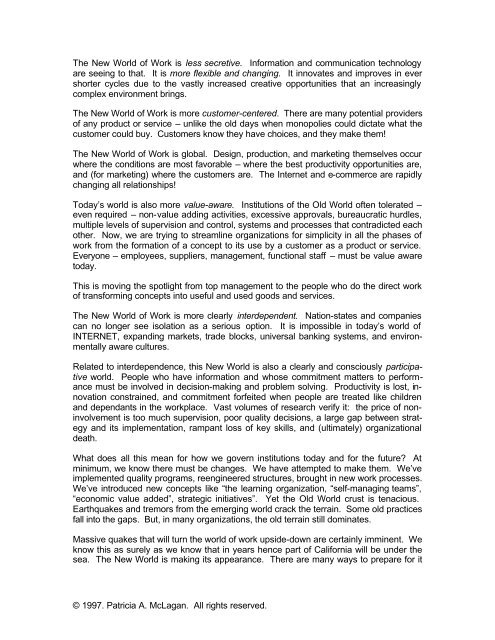Competency systems in the new world of work - McLagan ...
Competency systems in the new world of work - McLagan ...
Competency systems in the new world of work - McLagan ...
Create successful ePaper yourself
Turn your PDF publications into a flip-book with our unique Google optimized e-Paper software.
The New World <strong>of</strong> Work is less secretive. Information and communication technology<br />
are see<strong>in</strong>g to that. It is more flexible and chang<strong>in</strong>g. It <strong>in</strong>novates and improves <strong>in</strong> ever<br />
shorter cycles due to <strong>the</strong> vastly <strong>in</strong>creased creative opportunities that an <strong>in</strong>creas<strong>in</strong>gly<br />
complex environment br<strong>in</strong>gs.<br />
The New World <strong>of</strong> Work is more customer-centered. There are many potential providers<br />
<strong>of</strong> any product or service – unlike <strong>the</strong> old days when monopolies could dictate what <strong>the</strong><br />
customer could buy. Customers know <strong>the</strong>y have choices, and <strong>the</strong>y make <strong>the</strong>m!<br />
The New World <strong>of</strong> Work is global. Design, production, and market<strong>in</strong>g <strong>the</strong>mselves occur<br />
where <strong>the</strong> conditions are most favorable – where <strong>the</strong> best productivity opportunities are,<br />
and (for market<strong>in</strong>g) where <strong>the</strong> customers are. The Internet and e-commerce are rapidly<br />
chang<strong>in</strong>g all relationships!<br />
Today’s <strong>world</strong> is also more value-aware. Institutions <strong>of</strong> <strong>the</strong> Old World <strong>of</strong>ten tolerated –<br />
even required – non-value add<strong>in</strong>g activities, excessive approvals, bureaucratic hurdles,<br />
multiple levels <strong>of</strong> supervision and control, <strong>systems</strong> and processes that contradicted each<br />
o<strong>the</strong>r. Now, we are try<strong>in</strong>g to streaml<strong>in</strong>e organizations for simplicity <strong>in</strong> all <strong>the</strong> phases <strong>of</strong><br />
<strong>work</strong> from <strong>the</strong> formation <strong>of</strong> a concept to its use by a customer as a product or service.<br />
Everyone – employees, suppliers, management, functional staff – must be value aware<br />
today.<br />
This is mov<strong>in</strong>g <strong>the</strong> spotlight from top management to <strong>the</strong> people who do <strong>the</strong> direct <strong>work</strong><br />
<strong>of</strong> transform<strong>in</strong>g concepts <strong>in</strong>to useful and used goods and services.<br />
The New World <strong>of</strong> Work is more clearly <strong>in</strong>terdependent. Nation-states and companies<br />
can no longer see isolation as a serious option. It is impossible <strong>in</strong> today’s <strong>world</strong> <strong>of</strong><br />
INTERNET, expand<strong>in</strong>g markets, trade blocks, universal bank<strong>in</strong>g <strong>systems</strong>, and environmentally<br />
aware cultures.<br />
Related to <strong>in</strong>terdependence, this New World is also a clearly and consciously participative<br />
<strong>world</strong>. People who have <strong>in</strong>formation and whose commitment matters to performance<br />
must be <strong>in</strong>volved <strong>in</strong> decision-mak<strong>in</strong>g and problem solv<strong>in</strong>g. Productivity is lost, <strong>in</strong>novation<br />
constra<strong>in</strong>ed, and commitment forfeited when people are treated like children<br />
and dependants <strong>in</strong> <strong>the</strong> <strong>work</strong>place. Vast volumes <strong>of</strong> research verify it: <strong>the</strong> price <strong>of</strong> non<strong>in</strong>volvement<br />
is too much supervision, poor quality decisions, a large gap between strategy<br />
and its implementation, rampant loss <strong>of</strong> key skills, and (ultimately) organizational<br />
death.<br />
What does all this mean for how we govern <strong>in</strong>stitutions today and for <strong>the</strong> future? At<br />
m<strong>in</strong>imum, we know <strong>the</strong>re must be changes. We have attempted to make <strong>the</strong>m. We’ve<br />
implemented quality programs, reeng<strong>in</strong>eered structures, brought <strong>in</strong> <strong>new</strong> <strong>work</strong> processes.<br />
We’ve <strong>in</strong>troduced <strong>new</strong> concepts like “<strong>the</strong> learn<strong>in</strong>g organization, “self-manag<strong>in</strong>g teams”,<br />
“economic value added”, strategic <strong>in</strong>itiatives”. Yet <strong>the</strong> Old World crust is tenacious.<br />
Earthquakes and tremors from <strong>the</strong> emerg<strong>in</strong>g <strong>world</strong> crack <strong>the</strong> terra<strong>in</strong>. Some old practices<br />
fall <strong>in</strong>to <strong>the</strong> gaps. But, <strong>in</strong> many organizations, <strong>the</strong> old terra<strong>in</strong> still dom<strong>in</strong>ates.<br />
Massive quakes that will turn <strong>the</strong> <strong>world</strong> <strong>of</strong> <strong>work</strong> upside-down are certa<strong>in</strong>ly imm<strong>in</strong>ent. We<br />
know this as surely as we know that <strong>in</strong> years hence part <strong>of</strong> California will be under <strong>the</strong><br />
sea. The New World is mak<strong>in</strong>g its appearance. There are many ways to prepare for it<br />
© 1997. Patricia A. <strong>McLagan</strong>. All rights reserved.


